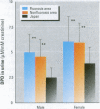Abstract
The combustion of high fluoride-content coal as an energy resource for heating, cooking, and food drying is a major exhaust emission source of suspended particulate matter and fluoride. High concentrations of these pollutants have been observed in indoor air of coal-burning families in some rural areas in China. Because airborne fluoride has serious toxicological properties, fluoride pollution in indoor air and the prevalence of fluorosis have been analyzed in a fluorosis area and a healthy nonfluorosis area in China and in a rural area in Japan. For human health, fluoride in indoor air has not only been directly inhaled by residents but also has been absorbed in stored food such as corn, chilies, and potatoes. In the fluorosis area in China, concentrations of urinary fluoride in the residents have been much higher than in the nonfluorosis area in China and in the rural area in Japan. In the fluorosis area, almost all elementary and junior high school students 10-15 years of age had dental fluorosis. Osteosclerosis in the skeletal fluorosis patients was very serious. Urinary deoxypyridinoline in rural residents in China was much higher than in rural residents in Japan. Data suggest that bone resorption was extremely stimulated in the residents in China and that fluoride may stimulate both bone resorption and bone formation. Because indoor fluoride from combustion of coal is easily absorbed in stored food and because food consumption is a main source of fluoride exposure, it is necessary to reduce airborne fluoride and food contamination to prevent serious fluorosis in China.
Full text
PDF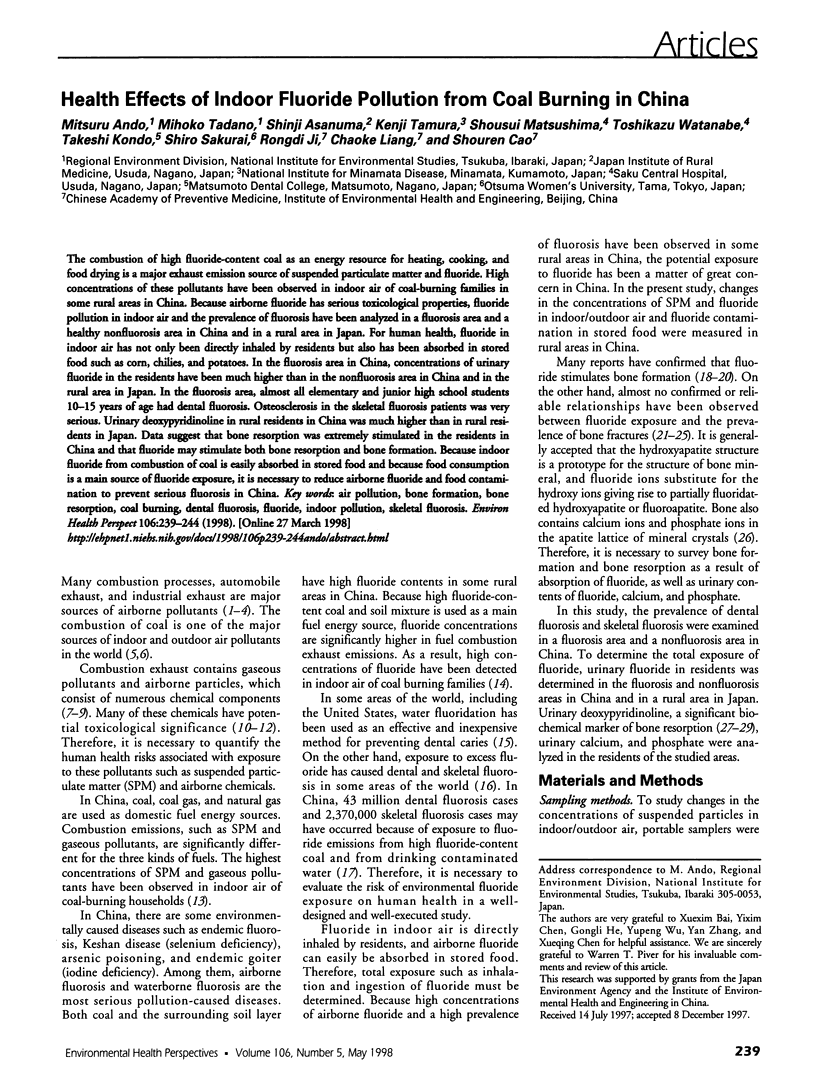
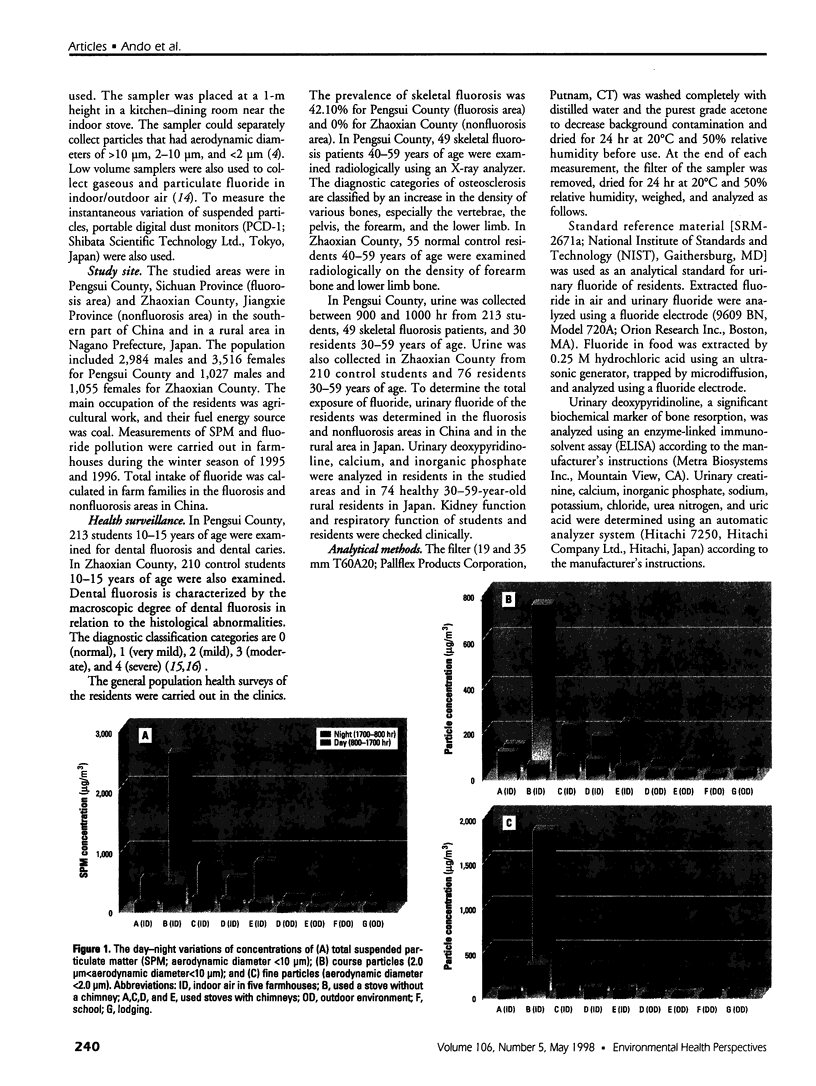
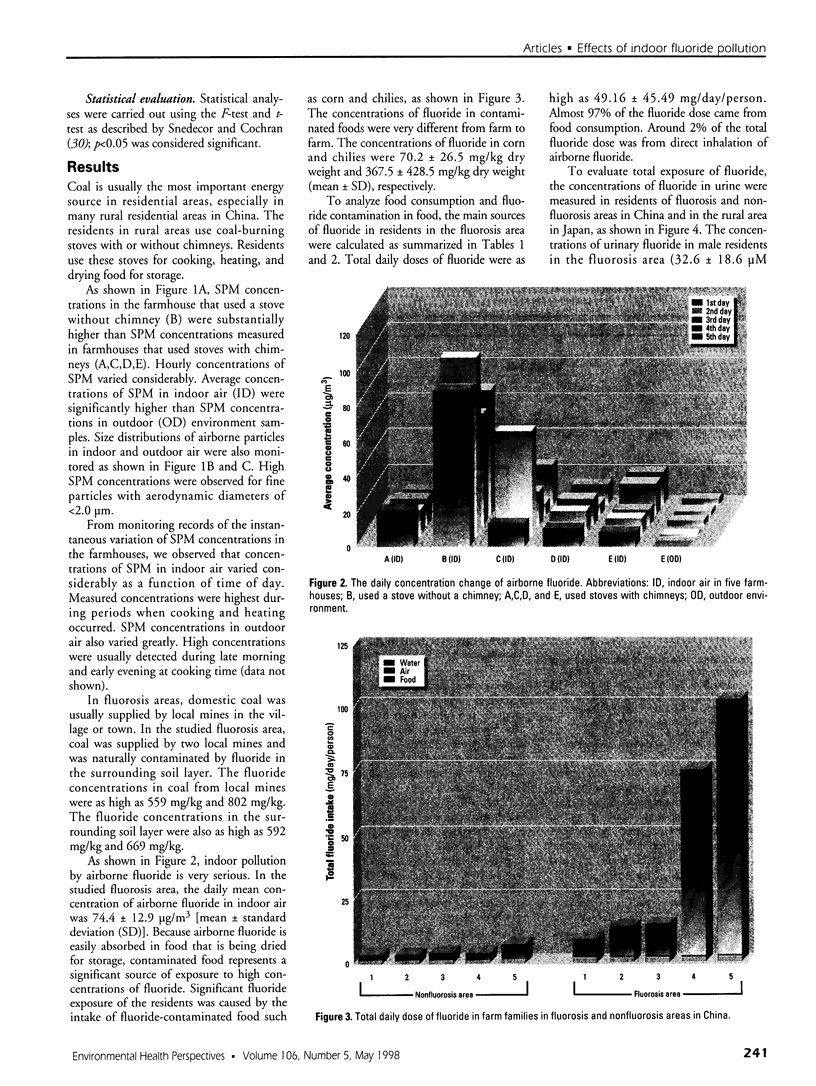
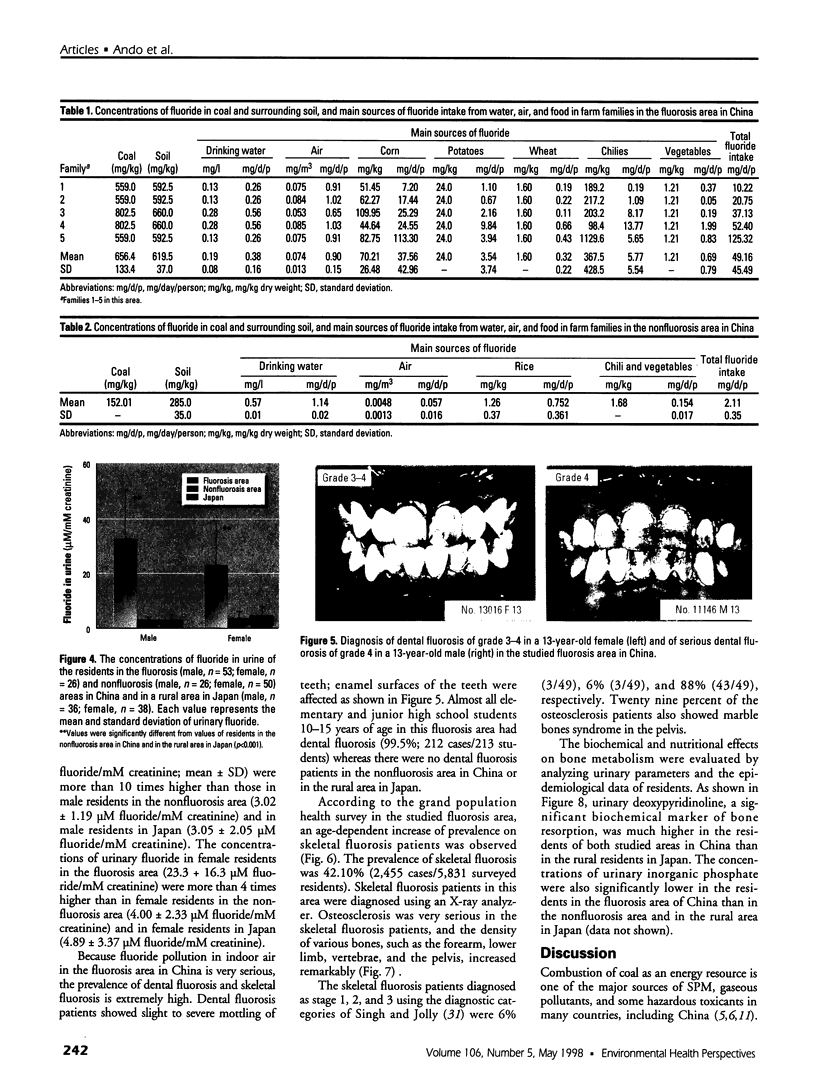

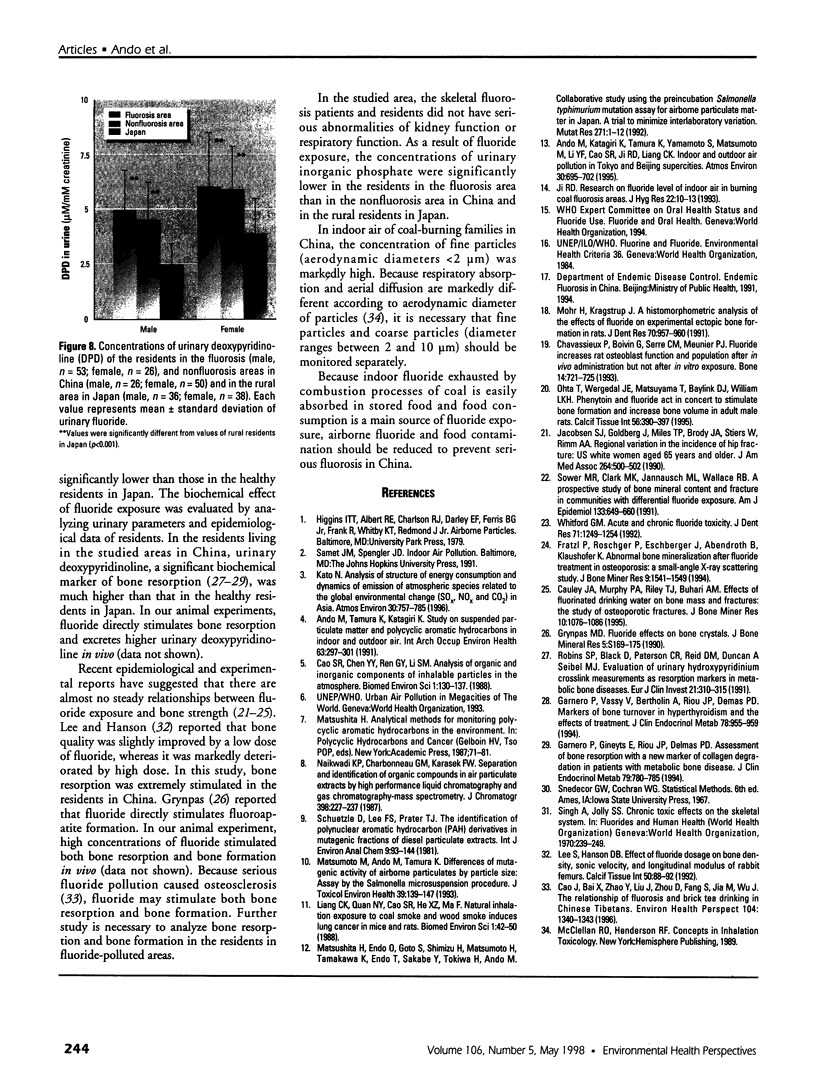
Images in this article
Selected References
These references are in PubMed. This may not be the complete list of references from this article.
- Ando M., Tamura K., Katagiri K. Study on suspended particulate matter and polycyclic aromatic hydrocarbons in indoor and outdoor air. Int Arch Occup Environ Health. 1991;63(4):297–301. doi: 10.1007/BF00386381. [DOI] [PubMed] [Google Scholar]
- Cao J., Bai X., Zhao Y., Liu J., Zhou D., Fang S., Jia M., Wu J. The relationship of fluorosis and brick tea drinking in Chinese Tibetans. Environ Health Perspect. 1996 Dec;104(12):1340–1343. doi: 10.1289/ehp.961041340. [DOI] [PMC free article] [PubMed] [Google Scholar]
- Cao S. R., Chen Y. Y., Ren G. Y., Li S. M. Analysis of organic and inorganic components of inhalable particles in the atmosphere. Biomed Environ Sci. 1988 Aug;1(2):130–137. [PubMed] [Google Scholar]
- Cauley J. A., Murphy P. A., Riley T. J., Buhari A. M. Effects of fluoridated drinking water on bone mass and fractures: the study of osteoporotic fractures. J Bone Miner Res. 1995 Jul;10(7):1076–1086. doi: 10.1002/jbmr.5650100712. [DOI] [PubMed] [Google Scholar]
- Chavassieux P., Boivin G., Serre C. M., Meunier P. J. Fluoride increases rat osteoblast function and population after in vivo administration but not after in vitro exposure. Bone. 1993 Sep-Oct;14(5):721–725. doi: 10.1016/8756-3282(93)90203-m. [DOI] [PubMed] [Google Scholar]
- Garnero P., Gineyts E., Riou J. P., Delmas P. D. Assessment of bone resorption with a new marker of collagen degradation in patients with metabolic bone disease. J Clin Endocrinol Metab. 1994 Sep;79(3):780–785. doi: 10.1210/jcem.79.3.8077361. [DOI] [PubMed] [Google Scholar]
- Garnero P., Vassy V., Bertholin A., Riou J. P., Delmas P. D. Markers of bone turnover in hyperthyroidism and the effects of treatment. J Clin Endocrinol Metab. 1994 Apr;78(4):955–959. doi: 10.1210/jcem.78.4.8157727. [DOI] [PubMed] [Google Scholar]
- Grynpas M. D. Fluoride effects on bone crystals. J Bone Miner Res. 1990 Mar;5 (Suppl 1):S169–S175. doi: 10.1002/jbmr.5650051362. [DOI] [PubMed] [Google Scholar]
- Jacobsen S. J., Goldberg J., Miles T. P., Brody J. A., Stiers W., Rimm A. A. Regional variation in the incidence of hip fracture. US white women aged 65 years and older. JAMA. 1990 Jul 25;264(4):500–502. [PubMed] [Google Scholar]
- Lees S., Hanson D. B. Effect of fluoride dosage on bone density, sonic velocity, and longitudinal modulus of rabbit femurs. Calcif Tissue Int. 1992 Jan;50(1):88–92. doi: 10.1007/BF00297303. [DOI] [PubMed] [Google Scholar]
- Liang C. K., Quan N. Y., Cao S. R., He X. Z., Ma F. Natural inhalation exposure to coal smoke and wood smoke induces lung cancer in mice and rats. Biomed Environ Sci. 1988 Jun;1(1):42–50. [PubMed] [Google Scholar]
- Matsushita H., Endo O., Goto S., Shimizu H., Matsumoto H., Tamakawa K., Endo T., Sakabe Y., Tokiwa H., Ando M. Collaborative study using the preincubation Salmonella typhimurium mutation assay for airborne particulate matter in Japan. A trial to minimize interlaboratory variation. Mutat Res. 1992 Feb;271(1):1–12. doi: 10.1016/0165-1161(92)90027-j. [DOI] [PubMed] [Google Scholar]
- Mohr H., Kragstrup J. A histomorphometric analysis of the effects of fluoride on experimental ectopic bone formation in the rat. J Dent Res. 1991 Jun;70(6):957–960. doi: 10.1177/00220345910700060901. [DOI] [PubMed] [Google Scholar]
- Ohta T., Wergedal J. E., Matsuyama T., Baylink D. J., Lau K. H. Phenytoin and fluoride act in concert to stimulate bone formation and to increase bone volume in adult male rats. Calcif Tissue Int. 1995 May;56(5):390–397. doi: 10.1007/BF00301608. [DOI] [PubMed] [Google Scholar]
- Robins S. P., Black D., Paterson C. R., Reid D. M., Duncan A., Seibel M. J. Evaluation of urinary hydroxypyridinium crosslink measurements as resorption markers in metabolic bone diseases. Eur J Clin Invest. 1991 Jun;21(3):310–315. doi: 10.1111/j.1365-2362.1991.tb01375.x. [DOI] [PubMed] [Google Scholar]
- Schuetzle D., Lee F. S., Prater T. J. The identification of polynuclear aromatic hydrocarbon (PAH) derivatives in mutagenic fractions of diesel particulate extracts. Int J Environ Anal Chem. 1981;9(2):93–144. doi: 10.1080/03067318108071903. [DOI] [PubMed] [Google Scholar]
- Sowers M. F., Clark M. K., Jannausch M. L., Wallace R. B. A prospective study of bone mineral content and fracture in communities with differential fluoride exposure. Am J Epidemiol. 1991 Apr 1;133(7):649–660. doi: 10.1093/oxfordjournals.aje.a115940. [DOI] [PubMed] [Google Scholar]
- Whitford G. M. Acute and chronic fluoride toxicity. J Dent Res. 1992 May;71(5):1249–1254. doi: 10.1177/00220345920710051901. [DOI] [PubMed] [Google Scholar]










